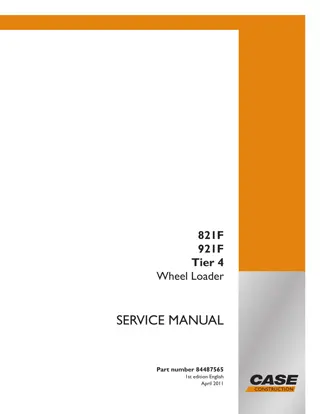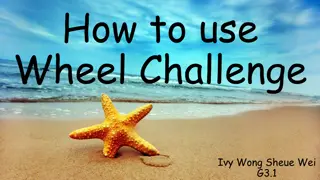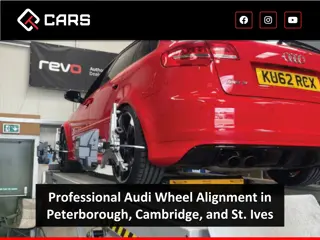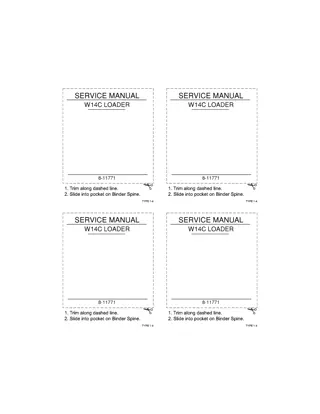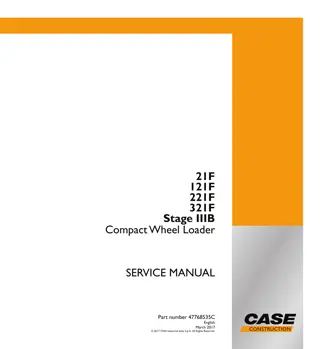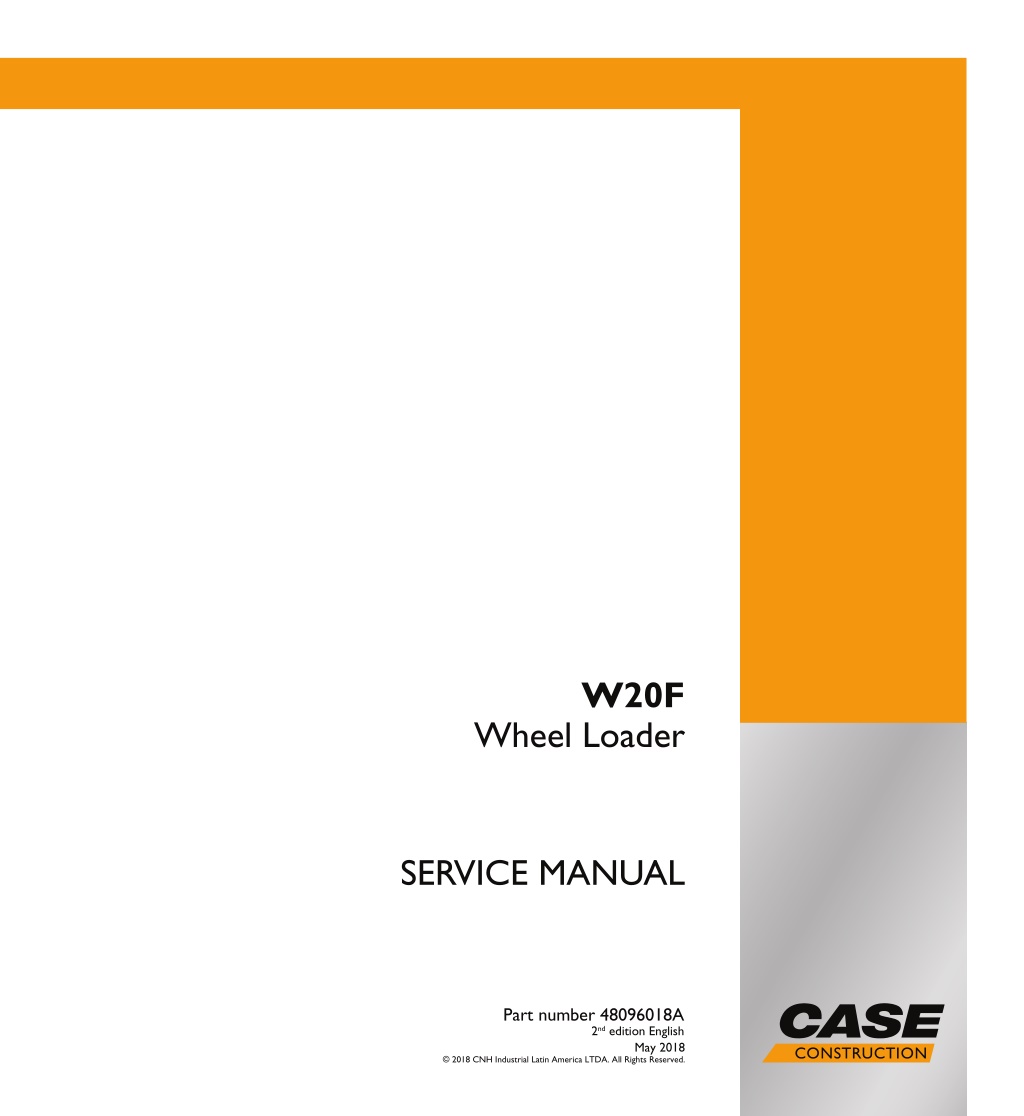
CASE W20F Wheel Loader Service Repair Manual Instant Download
Please open the website below to get the complete manualnn//
Download Presentation

Please find below an Image/Link to download the presentation.
The content on the website is provided AS IS for your information and personal use only. It may not be sold, licensed, or shared on other websites without obtaining consent from the author. Download presentation by click this link. If you encounter any issues during the download, it is possible that the publisher has removed the file from their server.
E N D
Presentation Transcript
SERVICE MANUAL W20F W20F Wheel Loader Wheel Loader 1/1 SERVICE MANUAL Part number 48096018 Part number 48096018A 2nd edition English May 2018 2018 CNH Industrial Latin America LTDA. All Rights Reserved.
SERVICE MANUAL W20F Standard model, with cab, Tier 3, made in Brazil W20F Fertilizer model, with cab, Tier 3, made in Brazil 48096018A 18/05/2018 EN
Link Product / Engine Product Market Product Australia New Zealand Engine W20F Standard model, with cab, Tier 3, made in Brazil W20F Standard model, with cab, Tier 3, made in Brazil W20F Standard model, with cab, Tier 3, made in Brazil W20F Standard model, with cab, Tier 3, made in Brazil W20F Standard model, with cab, Tier 3, made in Brazil W20F Standard model, with cab, Tier 3, made in Brazil W20F Fertilizer model, with cab, Tier 3, made in Brazil W20F Fertilizer model, with cab, Tier 3, made in Brazil W20F Fertilizer model, with cab, Tier 3, made in Brazil W20F Fertilizer model, with cab, Tier 3, made in Brazil W20F Fertilizer model, with cab, Tier 3, made in Brazil W20F Fertilizer model, with cab, Tier 3, made in Brazil F4GE9684T*J601 North America F4GE9684T*J601 Europe F4GE9684T*J601 Asia Pacific F4GE9684T*J601 Middle East Africa F4GE9684T*J601 Latin America F4GE9684T*J601 Asia Pacific F4GE9684T*J601 Australia New Zealand F4GE9684T*J601 Europe F4GE9684T*J601 Latin America F4GE9684T*J601 North America F4GE9684T*J601 Middle East Africa F4GE9684T*J601 48096018A 18/05/2018
https://www.ebooklibonline.com Hello dear friend! Thank you very much for reading. Enter the link into your browser. The full manual is available for immediate download. https://www.ebooklibonline.com
Contents INTRODUCTION Engine....................................................................................... 10 [10.001] Engine and crankcase ............................................................. 10.1 [10.102] Pan and covers .................................................................... 10.2 [10.202] Air cleaners and lines .............................................................. 10.3 [10.216] Fuel tanks .......................................................................... 10.4 [10.400] Engine cooling system ............................................................. 10.5 Main gearbox and drive............................................................... 14 [14.100] Main gearbox and drive ............................................................ 14.1 Transmission.............................................................................. 21 [21.114] Mechanical transmission ........................................................... 21.1 [21.113] Powershift transmission ............................................................ 21.2 [21.135] Powershift transmission external controls.......................................... 21.3 [21.155] Powershift transmission internal components...................................... 21.4 Front axle system ....................................................................... 25 [25.100] Powered front axle ................................................................. 25.1 [25.102] Front bevel gear set and differential ............................................... 25.2 [25.108] Final drive hub, steering knuckles, and shafts ..................................... 25.3 Rear axle system........................................................................ 27 [27.100] Powered rear axle.................................................................. 27.1 [27.106] Rear bevel gear set and differential................................................ 27.2 [27.120] Planetary and final drives .......................................................... 27.3 [27.124] Final drive hub, steering knuckles, and shafts ..................................... 27.4 Hydrostatic drive......................................................................... 29 [29.204] Reservoir, cooler, and lines ........................................................ 29.1 [29.218] Pump and motor components...................................................... 29.2 48096018A 18/05/2018
Brakes and controls .................................................................... 33 [33.202] Hydraulic service brakes ........................................................... 33.1 [33.110] Parking brake or parking lock ...................................................... 33.2 Hydraulic systems....................................................................... 35 [35.000] Hydraulic systems.................................................................. 35.1 [35.102] Pump control valves................................................................ 35.2 [35.106] Variable displacement pump ....................................................... 35.3 [35.300] Reservoir, cooler, and filters........................................................ 35.4 [35.359] Main control valve.................................................................. 35.5 [35.204] Remote control valves ............................................................. 35.6 [35.701] Front loader arm hydraulic system................................................. 35.7 [35.736] Boom hydraulic system ............................................................ 35.8 Frames and ballasting................................................................. 39 [39.100] Frame .............................................................................. 39.1 Steering..................................................................................... 41 [41.200] Hydraulic control components...................................................... 41.1 [41.206] Pump............................................................................... 41.2 [41.216] Cylinders ........................................................................... 41.3 [41.101] Steering control .................................................................... 41.4 Wheels...................................................................................... 44 [44.520] Rear wheels........................................................................ 44.1 [44.511] Front wheels........................................................................ 44.2 Cab climate control..................................................................... 50 [50.104] Ventilation .......................................................................... 50.1 [50.200] Air conditioning..................................................................... 50.2 Electrical systems....................................................................... 55 [55.000] Electrical system ................................................................... 55.1 48096018A 18/05/2018
[55.525] Cab engine controls................................................................ 55.2 [55.201] Engine starting system............................................................. 55.3 [55.301] Alternator........................................................................... 55.4 [55.302] Battery.............................................................................. 55.5 [55.610] Ground speed control .............................................................. 55.6 [55.050] Heating, Ventilation, and Air-Conditioning (HVAC) control system................. 55.7 [55.100] Harnesses and connectors......................................................... 55.8 [55.404] External lighting .................................................................... 55.9 [55.408] Warning indicators, alarms, and instruments .................................... 55.10 Booms, dippers, and buckets ....................................................... 84 [84.100] Bucket.............................................................................. 84.1 Platform, cab, bodywork, and decals............................................. 90 [90.114] Operator protections ............................................................... 90.1 [90.151] Cab interior......................................................................... 90.2 48096018A 18/05/2018
INTRODUCTION 48096018A 18/05/2018 1
INTRODUCTION Foreword - Important notice regarding equipment servicing All repair and maintenance work listed in this manual must be carried out only by qualified dealership personnel, strictly complying with the instructions given, and using, whenever possible, the special tools. Anyone who performs repair and maintenance operations without complying with the procedures provided herein shall be responsible for any subsequent damages. The manufacturer and all the organizations of its distribution chain, including - without limitation - national, regional, or local dealers, reject any responsibility for damages caused by parts and/or components not approved by the manu- facturer, including those used for the servicing or repair of the product manufactured or marketed by the manufacturer. In any case, no warranty is given or attributed on the product manufactured or marketed by the manufacturer in case of damages caused by parts and/or components not approved by the manufacturer. The manufacturer reserves the right to make improvements in design and changes in specifications at any time without notice and without incurring any obligation to install them on units previously sold. Specifications, descriptions, and illustrative material herein are as accurate as known at time of publication but are subject to change without notice. In case of questions, refer to your CASE CONSTRUCTION Sales and Service Networks. 48096018A 18/05/2018 3
INTRODUCTION Foreword - How to use and navigate through this manual This manual has been produced by a new technical information system. This new system is designed to deliver technical information electronically through web delivery (eTIM), DVD, and paper manuals. A coding system called SAP has been developed to link the technical information to other Product Support functions, e.g., Warranty. Technical information is written to support the maintenance and service of the functions or systems on a customer's machine. When a customer has a concern on their machine it is usually because a function or system on their ma- chine is not working at all, is not working efficiently, or is not responding correctly to their commands. When you refer to the technical information in this manual to resolve that customer's concern, you will find all the information classified using the SAP coding, according to the functions or systems on that machine. Once you have located the technical information for that function or system, you will then find all the mechanical, electrical or hydraulic devices, compo- nents, assemblies, and sub assemblies for that function or system. You will also find all the types of information that have been written for that function or system: the technical data (specifications), the functional data (how it works), the diagnostic data (fault codes and troubleshooting), and the service data (remove, install adjust, etc.). By integrating SAP coding into technical information, you will be able to search and retrieve just the right piece of technical information you need to resolve that customer's concern on his machine. This is made possible by attaching 3 categories to each piece of technical information during the authoring process. The first category is the Location, the second category is the Information Type and the third category is the Product: LOCATION - the component or function on the machine, that the piece of technical information is going to describe (e.g., Fuel tank). INFORMATION TYPE - the piece of technical information that has been written for a particular component or func- tion on the machine (e.g., Capacity would be a type of Technical Data describing the amount of fuel held by the fuel tank). PRODUCT - the model for which the piece of technical information is written. Every piece of technical information will have those three categories attached to it. You will be able to use any combi- nation of those categories to find the right piece of technical information you need to resolve that customer's concern on their machine. That information could be: the procedure for how to remove the cylinder head a table of specifications for a hydraulic pump a fault code a troubleshooting table a special tool 48096018A 18/05/2018 4
INTRODUCTION Safety rules Ecology and environment Soil, air and water are vital factors of life in general. Disposing of waste improperly represents a danger for the environment. NOTE: Some recommendations must be followed: Obtain information about the correct methods to recycle or dispose of waste from local authorities, collection centers or your dealer. Do not dispose of waste onto the ground, into drains, or in water beds. Do not fill reservoirs using cans or inappropriate pressurized fluid delivery systems, as they may cause considerable spillage. Use sealed containers when draining the fluids. Do not use containers for food or beverages which may induce ingestion. The air conditioning system is under pressure, and contains gases that should not be released into the atmosphere. Do not disconnect or remove any component from the pressure line of the air conditioning system. If you need repairs to the air conditioning system, contact a dealer. Immediately repair any leaks or defects in the machine's engine cooling and hydraulic systems. Generally avoid skin contact with any fuels, oils, fluids, acids, solvents, etc. Most of them contain substances which may be harmful to your health. Avoid spills when draining fluid. Store them safely until they can be disposed of properly in compliance with local legislation. Protect hoses and pipes during welding works, because the sparks generated during the welding work can damage them, allowing the fluid to leak. Mandatory recycling The battery is essentially composed of lead plates and sulfuric acid solution. Because the battery contains heavy metals such as lead, resolution 401 de 2008 of CONAMA orders that all used batteries must be returned to the bat- tery dealer at the time of replacement. Do not dispose of the battery in the garbage. Points of sale are obliged to accept the return of your used battery, and to store it in a suitable place and return it to the manufacturer for recy- cling. Improper disposal of batteries can contaminate the soil, groundwater and waterways. Consumption of contami- nated water can cause serious health risks. Contact of the acid solution with the skin or eyes can cause serious injury and blindness. In case of accidental contact with theeyesorskin, immediatelywashwithrunningwaterand seek emergency medical care. 1 CUIL13TRO0091AA 48096018A 18/05/2018 9
INTRODUCTION Safety rules (Signal word definitions) Personal Safety This is the safety alert symbol. It is used to alert you to potential personal injury hazards. Obey all safety messages that follow this symbol to avoid possible death or injury. Throughout this manual and on machine safety signs, you will find the signal words DANGER, WARNING, and CAU- TION followed by special instructions. These precautions are intended for your personal safety and for all those involved in the work activity during operation of the machine. Read and understand all the safety messages in this manual before you operate or service the machine. DANGER: Indicates an immediate danger that, if not avoided, will cause death or serious injury. The color associated with Danger is RED. WARNING: Indicates a potential danger that, if not avoided, will cause serious injury. The color associated with Warning is ORANGE. CAUTION: Indicates a potential danger that, if not avoided, can cause minor or moderate injury. ORANGE also alerts the operator to unsafe practices. The color associated with Caution is YELLOW. FAILURE TO FOLLOW DANGER, WARNING AND CAUTION MESSAGES COULD RESULT IN DEATH OR SERIOUS INJURY. Machine safety NOTICE: Indicates a situation that, if not avoided, could result in machine or property damage. The color associated with Notice is BLUE. Throughout this manual you will find the signal word Notice followed by special instructions to prevent machine or property damage. The word Notice is used to address practices not related to personal safety. Information NOTE: Indicates additional information which clarifies steps, procedures, or other information in this manual. Throughout this manual you will find the word NOTE followed by additional information about a step, procedure or other information in the manual. The word NOTE is not intended to address personal safety or property damage. 48096018A 18/05/2018 10
INTRODUCTION Product overview - (Machine Components) 1 COIL16CEX0166FA 1. Cab door 2. Handrail 3. Steps 4. Bucket 5. Bucket cylinder 6. ROPS Cab 7. Engine hood 8. Battery access 48096018A 18/05/2018 73
INTRODUCTION 2 COIL16CEX0172FA 9. Loader lifting cylinder 10. Cab air filter access 11. Loader lifting arm 48096018A 18/05/2018 74
SERVICE MANUAL Engine W20F Standard model, with cab, Tier 3, made in Brazil W20F Fertilizer model, with cab, Tier 3, made in Brazil 48096018A 18/05/2018 10
Engine - Engine and crankcase Engine - Service instruction Engine start ATTENTION: Fasten your seat belt before starting the machine. 1. Make sure that the bucket lever and the lifting arm lever are in neutral. 2. Apply the parking brake. 3. Place the gear lever in neutral. 4. Press the throttle to between one third and a half of its stroke. 5. Turn the ignition key to the start position, and secure it there to engage the starter motor and to turn the en- gine. 6. When the engine starts up, release the key. It will au- tomatically return to the normal operating position. NOTE: When turning the ignition key, the clutch pressure warning light, the oil pressure warning light, and the al- ternator warning light will all illuminate. When the engine starts running, these lights will turn off. If one or more stays on, turn the engine off immediately and investigate the cause. If the engine does not start at the first attempt, you must not try again immediately afterwards. Wait 30 60 s for the battery to recover, then start the engine again. 7. The injection pump is equipped with a variable speed regulator. Once the engine is running, the throttle should be released for a moment to allow the pump's maximum flow thrust to start working. 8. With the engine idling, at approximately 600 RPM, min- imum pressure should not be lower than 0.5 kg/cm2. At this point, the oil pressure warning light should switch off. If the pressure stated is lower than the specified pressure and the light does not extinguish, immediately stop the engine and check for the cause of the lack of pressure. 9. Do not accelerate the engine above idle speed immedi- ately after the start-up. This will allow the air pressure to fall within the green range and the parking brake to be released. 10. Themachinemustnotbemoveduntilthebuzzerstops sounding, until the air pressure gauge needle is in the green range, and until the parking brake is released. 11. During the starter drive, white or black smoke will be emitted from the exhaust pipe. If there is no smoke, or if the engine does not start, this means that the fuel is not reaching the cylinders. Investigate the cause. At the normal outside temperature, the engine must be heated at average rotations, without being forced. Ap- plyingthisprocedure, thenormaloperatingtemperature will be attained in a few minutes. For outside temperatures below 0 C, the engine must first be run in neutral at a moderate RPM, for a minute at the most. This will ensure that the cylinder walls and the journals are lubricated, even if the oil is cold. 48096018A 18/05/2018 10.1 [10.001] / 3
Engine - Engine and crankcase During operations Periodically observe the control instruments on the panel. If the battery charge warning light turns on while the engine is running, this indicates that the battery is not receiving charge. Also check the coolant water operating temperature and the oil pressure gauge. If any irregularity is identi- fied, stop the vehicle and identify the fault. 48096018A 18/05/2018 10.1 [10.001] / 4
Engine - Engine and crankcase Engine - Lubricate Lubricating your CASE machine will require just a few minutes of your attention every day. Where possible, CASE has introduced pre-lubricated or self-lubricating bearings, aiming to reduce the demands made on the operator s time. To ensure the maximum service life of the engine and your complete satisfaction, you must be sure to ob- serve the following: 1. Maintain a regular program of inspection and lubri- cation. All intervals in the Servicing Table and Pre- ventive Servicing Section are based on hourmeter readings. Readingthehourmeterfittedonyourtrac- tor will tell you when you need to inspect it and when it needs servicing. 1 LAIL11WL0583A0A 2. Use only good quality oils and greases that meet standard specifications. Use only oils and greases that meet the specifications recommended in this manual. 48096018A 18/05/2018 10.1 [10.001] / 5
Engine - Engine and crankcase Engine - Start up Preparing the machine for return to work Observe the following when you put the machine in working condition after it has been inactive for a long period: NOTE: Do not start the machine before you perform all of the actions listed below. 1. If all the fluid has been drained from the cooling system, fill the radiator with a mixture of clean water and anti- corrosive. For low temperatures use anti-freeze. 2. Ensure that the transmission oil level in the sump is correct. 3. Re-install the batteries. Ensure that they are charged. 4. Fill the tank with clean, water free fuel. 5. Replace fuel filters. Bleed all the air out of the fuel system. 6. Check that the tire pressure is correct. 7. Tighten the neck cap of the hydraulic reservoir filler. 8. Check all machine controls to ensure that they are not stuck. 9. Start the engine and idle it. Remove the valve cover to check that the valves are working, and that the rocker assembly is receiving lubrication. Flushing oil for the fuel system will cause blue-white smoke to come out of the exhaust for some time. This should not be a cause for concern because it will not cause any engine faults. 48096018A 18/05/2018 10.1 [10.001] / 6
Engine - Engine and crankcase Engine - Install 1. Lift the engine assembly to have free access to the installation points of the silent blocks on the cradles. NOTE: After removal, visually inspect the silent blocks. Check for cracks, drying out or damage on the silent blocks. If necessary, replace the silent blocks with new silent blocks before you install the silent blocks again. NOTE: All of the silent blocks consist of two parts. Place the part with the neck from bottom to top on the mount. 2. Install the silent block (1) on the right-hand engine mount (2). 3. Place the part with the neck from bottom to top on the mount. 1 COIL17WEL0548AB 4. Install the silent block (1) on the left-hand engine mount (2). 5. Place the part with the neck from bottom to top on the mount. 2 COIL17WEL0551AB 6. Install the silent block (1) on the left-hand side trans- mission mount (2). 7. Place the part with the neck from bottom to top on the mount. 3 COIL17WEL0550AB 48096018A 18/05/2018 10.1 [10.001] / 7
Engine - Engine and crankcase 8. Install the silent block (1) on the right-hand side trans- mission mount (2). 9. Place the part with the neck from bottom to top on the mount. 4 COIL17WEL0549AB 10. Movethelift equipment of theengine-transmissionas- sembly (1). Position the assembly so that the silent blocks are very close to the fastening cradles on the rear chassis (2). 11. Slowly lower the lift equipment. Align the bolts of the front engine silent blocks with the chassis assembly holes. If necessary, balance the assembly to make the bolt line up with the hole in the chassis. NOTE: Do not release the lifting equipment. Keep the as- sembly suspended until all the silent blocks are installed. 5 COIL17WEL0558AB Assembly of the left-hand front engine silent block 12. Install the bolt (1) and the top thrust washer (2) of the silent block. Install the bottom washer (3) on the top face of lower chassis cradle. 13. The washer (4) and the fixing nut (5) must be installed from the bottom of the chassis cradle. Thread the nut without tightening. 6 COIL17WEL0563AB Assembly of the right-hand front engine silent block 14. Install the bolt (1) and the top thrust washer (2) of the silent block. Install the bottom washer (3) on the top face of lower chassis cradle. 15. The washer (4) and the fixing nut (5) must be installed from the bottom of the chassis cradle. Thread the nut without tightening. 7 COIL17WEL0564AB 48096018A 18/05/2018 10.1 [10.001] / 8
Engine - Engine and crankcase Installation of the front part NOTE: Install the lower thrust washers of the silent blocks (3) on the top surface of the chassis cradles. Make sure that you install these washers correctly during assembly. 16. Slowly lower the lifting equipment. Align the bolts of the silent blocks with the assembly holes at the front of the engine. Move the assembly slightly until the two front bolts fit properly into the holes. Install the lower washers of the silent blocks in the correct position be- fore you fully lower the assembly. NOTE: Do not release the lifting equipment. Keep the rear part of the assembly suspended until all the silent blocks are mounted. Installation of the rear part Assembly of the left-hand transmission silent block 17. The fixing bolt (1) of the transmission screws should be installed from bottom to top. silent blocks sit directly on the surface of the chassis cradle. The transmission NOTE:Ifnecessary, balancetheassemblytomakethebolt line up with the hole in the silent block. 18. Insert the bolt (1) with the washer (2) through the drill hole in the chassis. Pass through the silent block. Install the thrust washer (3) and the nut (4). 19. Thread the nut (4) but do not tighten. 8 COIL17WEL0565AB Assembly of the right-hand transmission silent block 20. Insert the bolt (1) with the washer (2) through the drill hole in the chassis. Pass through the silent block. Install the thrust washer (3) and the nut (4). 21. Thread the nut (4) but do not tighten. 9 COIL17WEL0566AB 22. Lower the engine-transmission assembly completely onto the chassis. 23. Remove the lifting device. 24. Tighten the nuts of the fixing bolts of the front engine silent blocks to a torque 271 N m (200 lb ft). 25. Torque the transmission silent block fastening nuts to 415 N m (306 lb ft). 48096018A 18/05/2018 10.1 [10.001] / 9
Engine - Engine and crankcase Engine support and mounts - Install 1. Lift the already installed engine-transmission assembly toaccesstheattachmentpointsofthetransmissionand engine mounts. ATTENTION: Make sure that the hooks are securely at- tached to the engine hoist handles to prevent the assembly from dropping. 2. Position the cradle (1) on the thrust face on the trans- mission (2). Thread the bolts (3) with the washers (4). 3. Tighten the bolts in a criss-crossed pattern to a torque of 351 N m (259 lb ft). 1 COIL17WEL0545AB 4. Position the right-hand engine mount (1) in its thrust face (2), near the oil filter. Thread the bolts (3) with the washers (4). 5. Torque the bolts to 126 N m (93 lb ft). Start with the center bolt and then tighten the other two bolts. 2 COIL17WEL0546AB 6. Positiontheleft-handenginecradle(1)onitsthrustface on the engine (2), near the fuel filters. Thread the bolts (3) with the washers (4). 7. Torque the bolts to 126 N m (93 lb ft). Start with the center bolt and then tighten the other two bolts. 3 COIL17WEL0547AB 48096018A 18/05/2018 10.1 [10.001] / 10
Engine - Pan and covers Engine oil pan - Install Attach the fitting (7) to the engine sump. Attach fitting (6) to fitting (7). 1 LAIL11WL0446A0A Attach fitting (8) and (9) to the transmission. Attach the block (10) to fitting (8). Attach adapter (5) and pressure sockets (4) and (11) to the block (10). (8) Straight fitting (9) Swiveling 90 fitting (10) Block (11) Pressure switch 2 LAIL11WL0566A0A 48096018A 18/05/2018 10.2 [10.102] / 3
Engine - Air cleaners and lines Air cleaner - Install Fitting the original Mann Ltda. filters bracket 1 LAIL11WL0077F0A The mounting bracket is attached with 2 M8 bolts (torque 25 N m) Bolt: Nut: Washer: (not supplied in assembly) DIN 933 DIN 6924/6925 (self-locking) DIN 9021 48096018A 18/05/2018 10.3 [10.202] / 3
Engine - Air cleaners and lines Mounting the filter in the bracket 2 LAIL11WL0098F0A Place the filter in the mounting bracket and twist or push it into the correct position. Check that the filter fits into the clamp. NOTICE: Normally, the tightener spring is closed by hand, without the aid of tools. If that is not possible, check the filter position again to ensure that it fits correctly. In models with a dust flush valve and a horizontally- aligned installation position, the flush valve must be fac- ing downward (an angle of 15 from the OBEN / TOP mark is permissible). If necessary, remove the bottom, twist it to a new position and fit the filter again. If using a dust ejector, the outlet can be positioned at any angle around the housing. Position the tightener spring against the housing until it closes and locks. 48096018A 18/05/2018 10.3 [10.202] / 4
Engine - Air cleaners and lines Air cleaner - Remove Servicing the primary element Only service the primary element after the servicing in- dicator has illuminated and as per the instructions of the unit or the engine manufacturer. Removing the primary element Remove the base Loosen the catches and remove the base. 1 LAIL11WL0098A0A Remove the primary element Remove the primary element by twisting it slightly. 2 LAIL11WL0099A0A 48096018A 18/05/2018 10.3 [10.202] / 5
Engine - Air cleaners and lines Air cleaner - Cleaning Cleaning the primary element ATTENTION: Never wash or brush the primary element. When using an air jet, ensure that no dust enters the pri- mary element. Cleaning the primary element If necessary, the primary element can be cleaned up to 5 times. After that, the primary element must be re- placed. You can record how many times the primary element has been cleaned on the secondary element, using a pencil or a pen. To use an air jet on the filter element, connect a tube with a bent tip to a compressed air gun. The tip of the tube must be bent to approx. 90 . The tube must be long enough to reach the bottom of the filter element. Use dry pressurized air (max. 5 bar) to clean the filter element, moving the tube up and down inside the filter element until no more dust comes out. 1 LAIL11WL0003A0A Checking the primary element ATTENTION: Before replacing the primary element, en- sure that the element paper and the polyurethane seal are not damaged. Holes or cracks in the element paper are easily identi- fied by shining a flashlight inside the element. Never use a damaged primary element. If in doubt, always fit a new component. 2 LAIL11WL0004A0A Fitting the primary element First, gently push the open side of the primary element up to the top of the housing. Position the base correctly (check the position of the dust flush valve see point 2, above). Position the metal catches on the housing lip and tighten it by closing the catches (opposite way to Fig 3). 48096018A 18/05/2018 10.3 [10.202] / 6
Engine - Air cleaners and lines Replacing the secondary element Replace the secondary element every five full services of the primary element. Removing and cleaning the primary element (See above items.) 48096018A 18/05/2018 10.3 [10.202] / 7
Engine - Air cleaners and lines Air cleaner - Replace Replace the secondary element Do not clean the secondary element or re-use once it has been removed. Only break the seal when replacing the secondary element. Use a suitable tool (for example, a screwdriver) to push the secondary element seal outward and pull the two handles upward. 1 LAIL11WL0007A0A Use the two handles to hold the secondary element and then remove it with a gentle twisting motion. Insert a new secondary element. 2 LAIL11WL0008A0A Fitting the primary element (See above items.) Servicing the dust discharge valve Dust discharge valves require little maintenance. You can remove any dust build-ups by pressing the valve with your fingers. The valve must be released and not be in contact with any other components. Damaged valves must be re- placed. 3 LAIL11WL0009A0A 48096018A 18/05/2018 10.3 [10.202] / 8
Suggest: If the above button click is invalid. Please download this document first, and then click the above link to download the complete manual. Thank you so much for reading
Engine - Air cleaners and lines Disposing of used components Component Primary element Secondary element Casing Base Metal clips Mounting bracket Bracket tightener spring Other components and adapters Material Disposal As per local legislation As per local legislation Plastic recycling Plastic recycling Metal recycling Plastic recycling Metal recycling Plastic recycling Filter paper, polyurethane foam Polyurethane foam, plastic PP-T20 PP-T20 Steel spring PA6-GF30 Stainless steel 1.4310 TPO Storing filter elements ATTENTION: Protect stored filter elements from dust and moisture, avoiding agents that could damage them. The best way to store them is in the vertical position, in their original packaging. You should keep stock of at least one replacement filter for each filter element in use. 48096018A 18/05/2018 10.3 [10.202] / 9
https://www.ebooklibonline.com Hello dear friend! Thank you very much for reading. Enter the link into your browser. The full manual is available for immediate download. https://www.ebooklibonline.com





